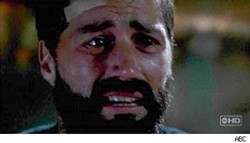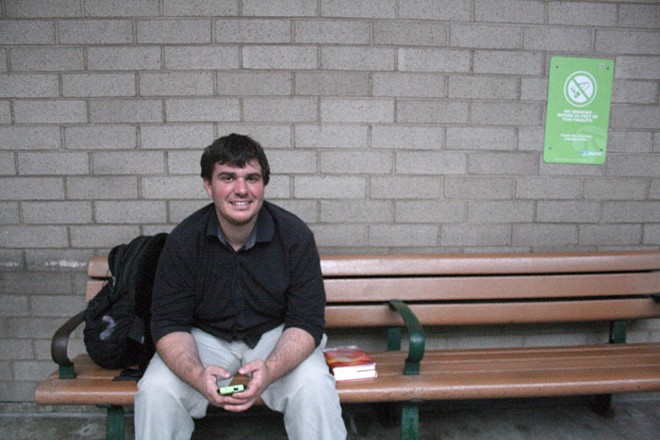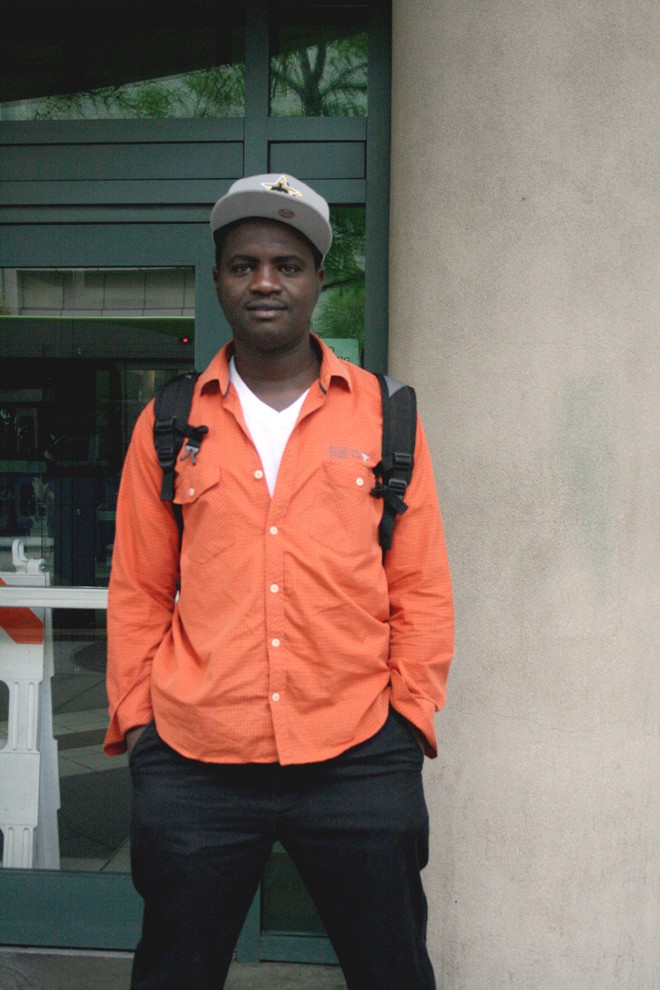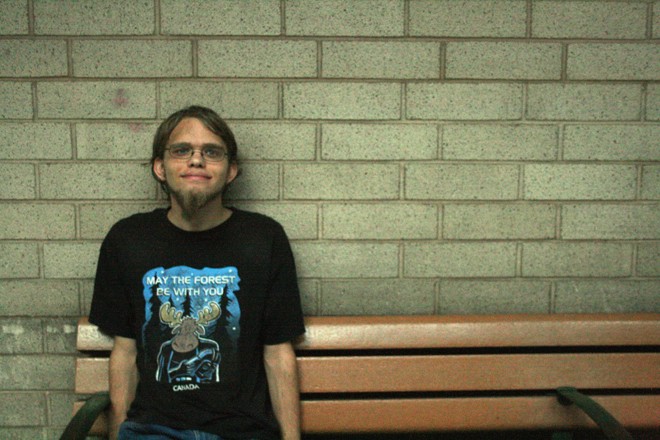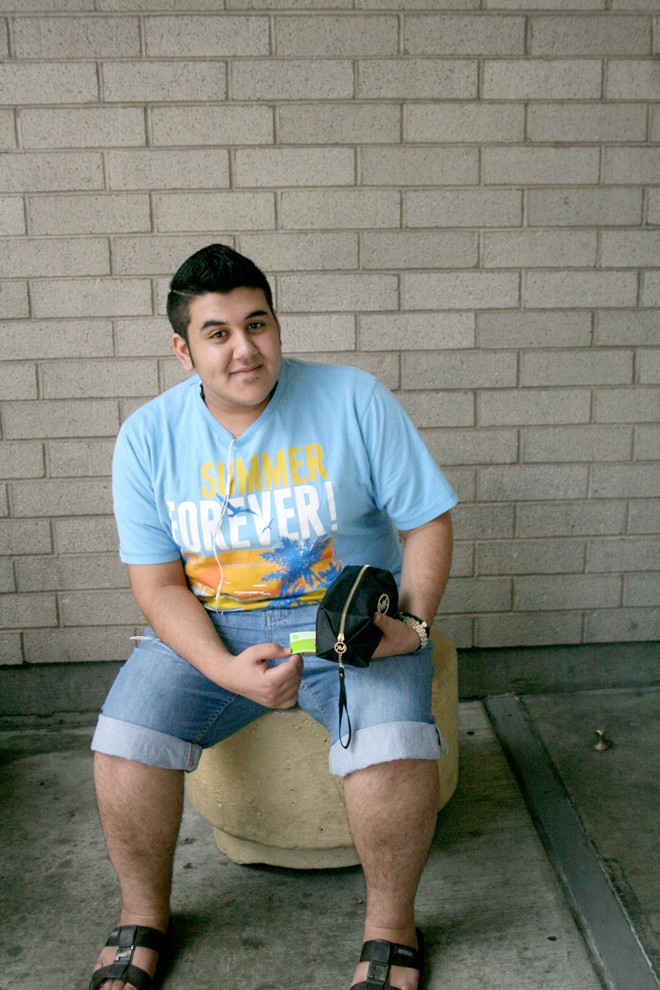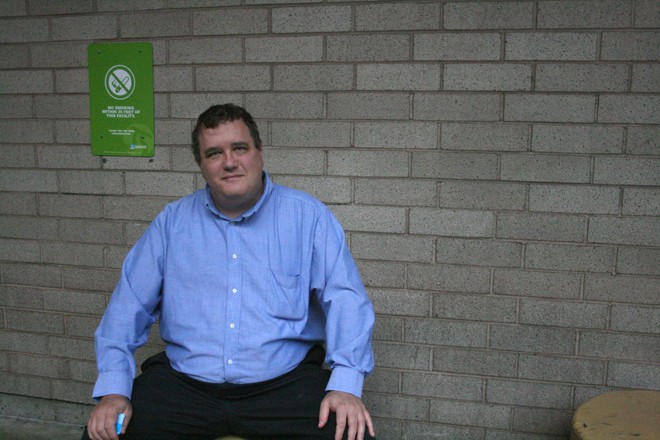Thursday, January 22, 2015
While it's her first column, it's certainly not the first time she's appeared in our pages. In 2008, we featured her in our "20 under 30" article highlighting the exceptional work of people under 30. And last year, Inlander readers voted her as the "Best Twenty-something Making a Difference."
No longer twenty-something, her work has taken her from government to biotech and public health, and we're honored to have her column every fourth week of the month.
Tuesday, November 25, 2014
Sadness quickly turns to madness when the loss of one of our sons and brothers is minimized and coded away in polite legal terms with no intention of returning what was taken, no attempt at apologizing for the damage done. Life meets death in the streets, where walking, shopping, driving, talking, playing on the playground or listening to music can be deadly these days… just being black in America.
The flames erupting in Ferguson are the fires burning in the hearts of mothers of black sons in this nation. We cry for the life nurtured inside us those nine months, for the years of tending and mending our child, for the brief pride we felt in his manhood before the light left his eyes. We tell our sons to walk with both eyes open, hands visible and quick feet ready to run. We advise them to keep receipts for everything they purchase, speak politely and dress sensibly. We hoped that the toil of our ancestors would have freed them from the curse of these limitations and the threat of harm, and we dreamed that we would never awake to feel this pain.
Where do we go from here? People who have not felt the lash of centuries of oppression beating down on their backs tell us to keep calm and carry on. What insanity makes those in power imagine they have any idea what the logical response should be? What psychosis perpetuates the myth that if we listen to “both sides,” we will somehow find the truth, as if the hunter and the hunted, the dead and the living, could be consulted with a fair and even outcome.
When my youngest son was 5 years old, an adult once asked him what he wanted to be when he grew up. He said, “A dog.” Laughing, the person said, “Oh, you mean you want to be a veterinarian?” “No,” he said, “I want to be a dog, because dogs have a life without worry.” The adult said, “Well, you know that’s not possible for you to be a dog.” Looking very serious, my son said, “Well, my mom said I can be anything I want to be when I grow up, and I think a lot of dogs have it easier than a lot of people.” Now that my son is 13, I sit him down to remind him of his early insights and, amid a swell of emotion, I tell him that, in America, a black 16-year-old who killed a dog was sentenced this summer to 23 years in prison, while a white police officer who was nearly 30 years old will not even face charges for killing a black teenager.
And, as the answers and questions blur together, I tell him that I cannot talk anymore about history or courts or reasons on this night. For a moment, I just need to hold him without words. ♦
Rachel Dolezal, formerly of the Human Rights Education Institute in Coeur d'Alene, is president-elect of NAACP Spokane and teaches courses in art, Africana history and culture at area universities.
Friday, November 21, 2014
Yesterday I went to the Spokane Transit Authority board meeting where the “task force” of concerned business owners — led by Greater Spokane Incorporated, Visit Spokane and Downtown Spokane Partnership — gave their opinion on how STA should use its Plaza.
The task force’s recommendations were mostly in line with STA’s existing plans, but they diverged in one hugely significant way. Rather than expanding the Plaza to bring in the community and create greater connectivity for non-transit users, they advocated the opposite.
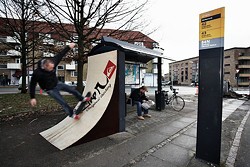
They suggested moving all services to the first floor. Shuttering the second almost completely. Removing the existing escalator and not replacing it. Restricting all retail uses to only the sorts of things that transit riders might be interested in.
The only concrete example of transit-specific retail the task force offered was “employment services.” You know, because everyone who rides the bus is unemployed, and everyone who drives a car has a job. So a WorkSource branch would be a perfect transit-specific tenant for the Plaza.
After the meeting, I drove back (sorry STA) to Fellow, the coworking space I started last year. As I was parking, I noticed a man urinating on the building between two cars in our lot.
He wasn’t drunk- or stoned-seeming. He was just a dude, in need of relief, taking a leak in broad daylight.
He noticed me as he was finishing up and, with a hip hitch and a zip of the trousers, he smiled and said, “Hi there.”
My first thought was how that parking lot experience felt like a metaphor for what had just happened at STA — someone coming to a place my friends and I have worked very hard to make cool and literally taking a piss on it.
But upon reflection, it’s most productive to think of the parking lot incident less as metaphor than an illustration.
The task force’s plans will never achieve their desired effect because you can never restrict use in public spaces enough to get rid of the parking lot pee-er.
Let me paint a picture of the space in which he was peeing: It’s a surface lot on a stretch of Howard that has almost no street-level retail. It’s also near the train tracks. No one purposefully walks around there unless they have very specific business in one of the handful of buildings on the block. And even then, people drive up, park as close to their destination as possible and shuffle quickly indoors.
I’ve seen people get in their cars and drive from one side of the tracks to the other.
I’ve never felt unsafe in this lot or on the street itself. It’s just ill-suited for pedestrians and starved for destinations. As a result, I have only ever had neutral, negative or just weird experiences on that stretch of road. No one besides our parking lot pee-er hang out there because, besides the beautiful new SUMAC mural under the trestle, no one has given those blocks a second thought for maybe a decade.
Conversely, all the traits that make it a bad place to hang out and have positive experiences is exactly what makes it such a prime place to drive up and find some random dude peeing. It’s secluded and empty of people.
We all recognize the STA Plaza currently suffers from usage woes. It’s a big space without much going on, and big spaces that are empty of people are hard to secure. Both the STA’s plan and the task force’s plan seek to solve this problem, but in opposing ways.
The STA wants to increase amenities to open usage to the entire community, offer more opportunities for engagement and make the Plaza a gathering place. The task force is asking STA to narrow the Plaza’s feature set to only the sorts of things bus riders absolutely need.
The problem with that plan, of course, is that the Plaza is still a public space. Even if you reduce the use to basically nothing, people are still free to hang out.
We know what public spaces with low use look like. They look like the parking lot near Fellow. They look like the stretch of Wall between Riverfront Park and Riverside. They look like the slope of hillside below the Post Street substation.
We also know how to make those places safer: make them more engaging. We turn an unused hillside into Huntington Park. We plan events to offset the lack of retail on Wall.
The crazy thing here is that DSP, GSI and Visit Spokane have all recognized this. DSP was absolutely instrumental in helping Terrain put on Bazaar, the art market we launched this June on a disused stretch of Wall St. I’ve had conversations with folks at Visit Spokane about their desire to drive tourism by activating public squares all around the city. All three entities were enthusiastic supporters of our recently passed park bond.
They totally understand the vision!
I worry though, that because of the fraught, 20-year political history of the project, and the pressure being exerted by certain downtown businesses, no one is recognizing that the Plaza has the exact same potential for activation as Huntington Park or Wall Street. Honestly, I think it has an even greater potential, because it’s indoors and is already the nexus of our transit system.
Let me be the person who says this: Good as it is, I don’t think STA’s plan goes far enough.
One of the greatest revitalizations of a public space I know of is the transformation of Portland’s Pioneer Courthouse Square from a squat parking garage in the middle of the city into a thriving meeting place.
They did it with smart planning aimed at attracting the greatest diversity of people possible — just like STA has done — but then they went further: creating a separate entity to program the space, filling it with cool stuff a couple hundred times a year. Now it’s the home of concerts, festivals and events, a hub of downtown Portland, and a big tourist attraction.
Now imagine how it would feel if a tourist or business traveler coming to Spokane for the first time grabbed the shuttle from the airport, rode downtown and found themselves disembarking onto an art market, or a free concert, or just a bustling place with a diversity of people and a diversity of shops.
Isn’t that the sort of town you’d want to explore? Like, “Wow, if their bus Plaza is crackling like this, what must their clubs be like? Their restaurants? Their neighborhoods?”
Then who better to ferry that person around to those destinations than, you know, STA itself. The word “synergy” gets thrown around, but come on now.
Now imagine that same tourist getting off the shuttle to a Plaza renovated according to the task force’s specifications: a smaller, more utilitarian space for the workmanlike ferrying of people from place to place, with maybe an employment office in one corner.
At any other time than peak hours, the space would feel empty and maybe a little alienating. If that tourist had to spend any time waiting for a transfer in the task force’s version of the Plaza, I honestly ask myself who he or she would run into.
It’s still a public space, even if no one’s using it, so the only person I’d put money on is that smiley guy from the parking lot, making the most of the solitude to take a quiet pee in the corner.
Luke Baumgarten is the interim co-executive director of Spokane Arts, a cofounder of Terrain, the founder of Fellow Coworking and former culture editor of the Inlander. He tweets @lukebaumgarten.
Friday, October 3, 2014
How To Get Away With Murder, despite nearly every character acting the sneering villains the college comedy slackers would humble with a crazy prank, is shaping up to be one of the most enjoyable new shows. It’s got that shamelessly dramatic dialogue, monologues and plot-twists of the best guilty pleasures.
But almost immediately, it has a big flaw stuck into the very structure of the show: It gives us brief “flash-forwards” into a scene where the characters appear to be hurriedly covering up a murder.
The flash-forward gimmick is hardly a new one.
How To Get Away With Murder’s device is an almost exact ripoff of one of the worst parts of another legal thriller, Damages. That show parceled out the narrative in the present with brief glimpses of the future — horrible things happening to an ambitious legal mind due to her involvement with a take-no-prisoners female mentor. (How To Get Away With Murder distinguishes itself by giving us glimpses of horrible things happening to multiple ambitious legal minds due to their involvement with a take-no-prisoners female mentor.)
It’s a device that’s been used in shows like Lost, Breaking Bad, and How I Met Your Mother. And it hurt every one of them.
Heck, there was even a television show called FlashForward that made this the entire premise – that everyone on earth sees a vision of themselves from the future — and it buckled and collapsed under the strain almost instantly.
The temptation for a writer to put a flash-forward in a pilot is understandable. It’s a promise: This is how crazy things will get. It’s supposed to be like your friend saying, "Hey, stick with it, the show gets really good around episode 22."
But flash-forwards ultimately are more like skeevy payday loan operations: They borrow interesting narrative from the future to spend in the present. And the interest rates are downright predatory.
To expand on that: One of the most enjoyable parts of watching TV is asking two fundamental questions: 1) What is happening now? 2) What will happen next? Yet a flashforward spoils the answer to #2 and makes the answer to #1 feel irrelevant. Both questions are replaced with “How does the story get from A to B?” (Or A to Z.) That’s not a mystery or an adventure. That’s a MapQuest printout.
A flashback is problematic because it kills narrative momentum by taking us out of the present. Why would I care about what happened six months ago? I want to know what’s happening now. But flash-forwards turn almost the entire show into one giant flashback. It cheapens what’s happening in the present by showing us the consequences.
Sometimes those flash-forwards are lies: They use unreliable narration, deceptive editing or trick camera angles to pretend something will happen when it won’t. But that breaks the trust between viewer and show, which greatly harms future seasons.
How I Met Your Mother had to bend over backwards to try to fulfill the many promises the show had made about the future and still surprise the audience. The result had the fans angry and revolting.
Other times, the flash-forwards are the exact truth, creating expectations difficult to fulfill: The reveal of Lost’s flash-forwards made for an iconic moment, for example, but the story struggled to fill in the gaps in a logical, satisfying way.
Mind you: A flash-forward can work brilliantly in long-form non-fiction journalism. Even novels, to a certain extent, can benefit from this sort of structure.
But a serialized TV drama is not a novel or long-form non-fiction. It is a serialized TV drama – and one of its biggest strengths should be its agility. The story is a living, breathing thing that can veer off in wonderfully surprising directions. A plotline that’s not working can be excised, a character can be killed off, a more interesting thread can be pulled. Most of the time, it’s not the vision of one mind, it’s a room of writers. Epiphany can strike and transform a show at any time.
Actors quit. Actors die. Ratings fall. Writers change their minds.
In some cases, a flash-forward can work within a single episode. A Breaking Bad episode opens with the serial image of bullet shells on the hood of a car, bouncing as hydraulics send the car up-and-down. It’s a tease more than a spoiler. It’s a poetic image that hooks and intrigues.
But Breaking Bad stumbled when it tried to create season-long flash-forwards. It famously began its 5th season with a bearded Walter White opening up his trunk to reveal a massive machine gun. At the time the writers had no idea what it would be used for.
The result was the worst of both worlds: The constraints of a perfectly planned show and the lack of foresight of an improvised one. Partly as a consequence, the finale to one of TV’s best shows of all time was, ultimately, disappointing.
How To Get Away With Murder doesn’t aspire to Breaking Bad’s greatness. But it wants to be surprising, fun and fast-paced – and flash-forwards make every one of those goals more difficult.
Monday, September 15, 2014
You see, I was an award-winning artist at the break-point in my career when I moved to … Idaho. As you might guess, gravity didn’t carry me up from there. A failed marriage and subsequent custody order decided that this is where I would live for the next 15 years. Sure, I’ve made what I could of a secondary career and might be what some would call a success, but I still feel the sadness resurface when I think of lost momentum and the years I’ve struggled back at square one to re-launch into something amazing.
For all of us who were headed to the top of our career fields with visions of changing the world, an ordinary life of paying bills and rolling out the recycle bin on garbage day is such a let-down that we often distract ourselves by any means necessary, sedating the pang of disappointment and failure. Craft beer, Netflix, Mary Jane, Crossfit, making jam and Seahawks football are on the seasonal escape menu. Our routine eventually becomes a seamless rhythm between duties and diversions, played out through the years as we forget to remember what it was we were supposed to be and who we have meanwhile become.
I can’t help but think of the poem "A Dream Deferred," written by Langston Hughes, that gives shape to this feeling of being stuck in a holding pattern in life:
For some, acceptance of what has been and what is can be a soothing balm to assuage the potential terror that comes with knowing the nearness of the end of our life script. For others, the “thinking positive” thing works, or outright denial of the situation, religion, or maybe participating in that Facebook gratitude challenge. After trying all of the above and tiring from the strain of spotting the silver lining, these are the three things that stay with me:
1) Never get tired of making a plan. Whether you planned your work but your work didn’t go as planned, your plan was eliminated by another person, or circumstances downright derailed Plan A, B and C, it is never too late to forge Plan X, Y, and Z. Planning forces solutions to emerge and often leads to the type of creativity that eliminates a forever-stuck scenario. At the worst, it is an illusion of going somewhere, and that — at least for a moment — can seem like forward motion.
2) Remember what matters most to you. Whatever inspired you to set your big dreams of adulthood as a child must still be somewhere inside of you. Reconnect with that unique inspiration of your inner superhero and be honest about what drives you and what doesn’t. Sometimes we stop caring about life because we forget what people, causes and experiences move us past coping and make it exciting to be here. We have built our lives around things that really don’t matter to us, so we find ourselves no longer being interested in living.
3) Fall in love. Whether it’s a deep love for your child, yourself, a partner, or all three, a deep level of human connection is one of those things that feeds us. You can’t get it with an EBT card or buy it with an entire bank, but it is available to us all. Believing that we are completely lovable and capable of loving is one of the most freeing experiences of the human story.
Whether your dreams are crusted and sugared over with sweet distractions or sagging like a heavy load, I hope that as individuals and a community we can reconnect with our inspiration, find the love and support we need, and make solid plans for our dreams to be revived and explode into reality!
Tags: Commentators , Comment , Image
Wednesday, September 3, 2014
We bounce from the funniest and cutest baby animals to the most shocking and appealing incidents as we casually scroll through Facebook, Instagram, Snapchat or the news. We do just enough to protect those closest to us and starve the others from our compassion. But, of course we don't think of it that way. No, once in a while, the best of us throw a crumb of surplus energy/money/time to that person whose struggle is foreign to our own. It makes us feel better and becomes the lubrication for our continued socioracial patriarchal capitalist masturbatory lifestyle.
But what does it all matter? Our charity, our organizations, our churches, our clubs and causes? Do they only amount to the warm fuzzies of a few success stories plastered on our fundraiser fliers or "meaningful" conversations over coffee at Lindaman's? Am I the only one who was not only surprised but also disturbed by the sheer number of do-gooder postings in the “Give Guide” in August’s Inlander? What's wrong with a society that has this many outreach groups and yet no shortage of need and deficit on the streets or in family homes throughout the area? Are we scratching our own backs or really creating social transformation?
As protesters continue to march in Ferguson, what are we doing that is really bringing about a more just and equitable society in Spokane and North Idaho? As millions of dollars are raised in the ALS Ice Bucket challenge, how many people are dying without clean water or with the Ebola virus? What will be the next Twitter #trend? How quickly we moved on from the #bringbackourgirls campaign, the fevered pitch of need now a distant echo in memory? Something about girls from Nigeria being kidnapped. Not our daughters. Forgettable indeed. Who else is forgettable in time? Otto Zhem? Isamu Jordan? All of us? Stories of struggle that once shook our fair city fade into insignificance as we move to the tempo of the latest dance vine and blog thread. We fast-tracked through summer burgers and beer, retail weed stores opening, entertainment and camping, kayaking and huckleberry picking, and now it's back to school for the kiddos. Soon, we will be winterizing our homes and hitting the ski mountain. Just to do it all over again next year?
I asked my son yesterday if he is all ready for seventh grade. Without hesitation, he said, "Ya, pretty much. I've got basically everything except white privilege." His words have been haunting me ever since, with the memory of last year starting out with him getting a concussion, followed by other bullying incidents and social challenges at school here. What exactly does white privilege mean to a 12-year-old embarking on seventh grade …at Sacajawea Middle School? What does white privilege mean in Spokane, or North Idaho in general? I think of him turning 13 this October and feel powerless to spare him from the daily reminders of white privilege, or maybe more accurately white supremacy... the school curriculum, the school staff demographics, the student body, the national news stories. In case you’ve missed them: more young Black males being beaten, shot, arrested, or killed, while their white counterparts get away with… yes, sometimes murder.
How do I prepare him, how do I prepare myself, how do we continue to live and move in a society that is rewinding at warp speed back to the days of the "I am a Man" Civil Rights era? Do we just keep our heads down, get that bread and send our kids to school, hoping for the best? Do we stand on street corners, wave flags and protest? Do we go back to boycotts and sit-ins and not quit… until the Nigerian girls are rescued, the Ebola virus is cured, and justice is served for Mike Brown's family? Or until our own children legitimately have a fair and equal chance at self-determination and the pursuit of happiness in America and in Spokane? How far does our compassion reach: across the hallway, down the street, to Pullman, to Seattle, to Ferguson, to Nigeria or Sierra Leone? Are we living and loving too casually, or why is so much left undone with aborted attempts at realizing equity and justice?
The noise of injustice is what I hear turning up right now, and the volume of all of this is getting too high. The levy might not hold. Everything might not be ok. It all might not really be happening for a (good) reason. The apathy around us, the materialism and consumerism and self/now mentality is but a mutation of the disease of white supremacy, running amok in our limbs as a cultural body. History is repeating, and this time it will take a headshot to kill the monster preying on our people, because we are on a quick sprint to becoming the walking dead.
Tags: Comment , commentators , Image
Friday, August 22, 2014
I sometimes wonder if the people in charge of and concerned about downtown Spokane live in the same downtown Spokane that I do. If you based your knowledge of Spokane on the comment threads of local news outlets, letters to the editor and the loudest opinions within business leadership, you’d probably believe that our core is positively overrun with hoodlum youth, aggressive and dangerous panhandlers, and all-purpose chaos. On the contrary, while I do get asked for money during maybe 15 percent of my outings downtown, I don’t witness any of this behavior at a noticeable level. I notice that there are people around, on a good day, who are up to all types of things. There are business men walking five abreast on the sidewalk with coffees, people on cell phones, shoppers laden with bags, young people cradling either guitars or puppies, skaters, people in electric wheelchairs dodging through the sidewalk traffic.
In short, there are a wide variety of humans co-mingled in one space. They don’t all look the same, they don’t all share the same values, and the day-to-day of their lives vary wildly. This is as true next to River Park Square and in Riverfront Park as it is at the STA Plaza. However, the characterization of the Plaza’s inhabitants and users casts bus riders as dangerous, poor (which is bad and probably also their fault, right?), and a nuisance to polite society. I have a hunch that the critics of the Plaza are comprised of the group least qualified to have an opinion on the matter: people with cars who almost never ride the bus. I tend to agree with what Bruce Nourish pointed out in his Seattle Transit Blog post about the Plaza feud: “What really ails Spokane’s retail plutocrats is not the people of the Plaza, but their own ignorance."
Part of my ongoing frustration as a decades-long STA patron is people’s attitude toward bus ridership. Their complaints about slow service, or a lack of service in their area, or lack of connections make up a self fulfilling prophecy. Without the patronage of more people in Spokane, equalling more money for STA’s operation, the services cannot improve. More people ride the bus than ever before in Spokane now and it’s due to many factors. And they are all kinds of people representing a cross section of the bottom 80 percent of income earners in the area. Here are some photos and short interviews that I conducted on Wednesday, Aug. 20 around 3 pm on the south side of the Plaza. I hope that for those who are ignorant about bus ridership in Spokane or in general, these examples can show you that there really isn’t anything to be afraid of. After all, can you read while driving or have an undistracted conversation with your kids or friends?
Jarrod commutes to Cheney for both work and school. He said that, “The only bummer [about taking the bus] is that it takes longer... but that’s what books and smartphones are for.” Overall he describes STA as a good transit system. “They stop frequently. You don’t have to walk too far to find a spot.” As for the Plaza’s downtown location, he wouldn’t change it. “It is literally in the middle of everything.”
On Wednesday, Scott was heading out the the VA. He said that he takes the bus at least six times a week, mostly to appointments. His favorite aspect of riding the bus? “It’s really convenient, pretty close to where I want to go.” He, too, had a book with him for company on the ride. Other than putting up with the occasional crying baby, he doesn’t mind taking the bus. He was familiar with the concerns about the Plaza. “A lot of kids and homeless come here, but they will be around no matter what, no matter where it is."
Khaled takes the bus to and from work every day. “I have a good time and the people are fun," he said. “This is a good place, because you can learn how to go anywhere from downtown."
When I told Traci I was taking pictures to show that bus riders are just normal people, she laughed and agreed. “It’s just a big pot of everyone here,” she said. On Wednesday, Traci was on her way to the Maple CHAS clinic, but she takes the bus anywhere she needs to go for the most part. I asked her to describe the Plaza in three words. “Not that bad!”
Steven was on the way home from taking the placement exams at SFCC when I talked to him on Wednesday. He doesn’t take the bus often, but said that the downtown location “seems to be working.” His only complaint was that the bus takes a while, but that he’s glad it’s “fairly cheap to ride."
Mohammed takes the bus anywhere he needs to go in town. On Wednesday, he was even getting ready to move from an old apartment to a new one using the bus. He didn’t seem discouraged by this task and said, “It is a great bus! I love to be able to use it every day.”
With Mohammed was Mahadi, who didn’t want his photo taken. He was on his way to his school, just across from the Riverside entrance of the Plaza, the Spokane College of English Language. He doesn’t have a car, like many other bus riders and me. He said, “It is a great thing that this city has the bus because all the people depend on it."
Sam was about to catch the bus into Browne’s Addition to go to Rosauers, one of the only grocery stores near downtown, when I asked her about STA. She takes the bus almost every day and described it as loud. “It can be kind of sad sometimes. But it also opens people up for conversations. Like, do you want to talk for 20 minutes? And I guess that can be a good thing."
Bret has been riding the bus for 10 years. On Wednesday, he had just finished up working downtown. He was very familiar with the ongoing disapproval of the Plaza from certain business interests in the city center. He said, “Moving it isn’t a solution. It’s just an easy target. [The critics] have to blame their poor business acumen on something and right now it’s the homeless and the street kids. But where else do they have to hang out?” He pointed out that as a business person, he likes having the Plaza right in the middle of things because it brings people, many of whom are customers, to the businesses who rely on them for success.
“Don’t get me wrong, I love Spokane," he said. “But in some ways, Spokane is still really in an early 20th century mindset. The 1950’s aren’t coming back."
Tuesday, August 19, 2014
But at its heart, journalism is about serving the public — first, by going where average people have neither the time nor the inclination to go. To city council meetings. To crime scenes. To war zones. And then: relaying what was learned as honestly and candidly as possible. There is something worthy in that endeavor, and the sacrifices of our journalists can be enormous.
Just today, news broke that militants from the Islamic State claimed to have beheaded American journalist James Foley, who was kidnapped two years ago in Syria. The same group claims to have another captured journalist, Steven Sotloff, who it intends to kill if the United States continues airstrikes in Iraq.
Meanwhile, New York Times reporter James Risen is fighting the Obama administration's efforts to force him to reveal his sources for a story in his 2006 book, State of War: The Secret History of the CIA and the Bush Administration. He could end up in prison if he doesn't relent, but the charge against Risen isn't about lying — it's about revealing secret truths.
And in Ferguson, Missouri, reporters are stocking up on gas masks and bullet-proof vests, while 11 cohorts have been arrested covering the protests.
Journalists aren't saints. Many are jackasses. But the vast majority believe in what they do, and do it despite the pay scale or the public's disdain or the very real dangers they may encounter.
Thursday, August 14, 2014
Now, we can observe the same pattern unfolding in news stories and on comment threads everywhere in the wake of racially-tinged police violence and a community’s reaction to it in Ferguson, Missouri. From the first protests where multiple media outlets mistakenly printed that protesters were heard chanting “Kill the police” when they were in fact chanting “No justice, no peace”, to the dozens of tangents that distract from the fact that yet another unarmed, black young person has been killed by police under questionable circumstances. Just as the bulk of those blaming women for sexual assault are men, and the people criticizing Palestinians for not being submissive enough to occupation are people who have never lived under occupation, mostly white and especially white middle-class people seem to be levying most of the criticism of Michael Brown’s life before he was killed last week or of his community’s reaction to yet another of its children dying in such a manner.
The rabid denial that racism is a major part of U.S. institutions and daily life belies how ingrained it is in society and how effectively it entrenches itself. Evidence of white privilege is everywhere, yet pundits and bloggers amass an audience who believes that there is an honest to goodness “war on whites” or the more subtle arguments that “political correctness” is ruining lives everywhere. You don’t see racism, you say? That’s because, if you are a white person reading this, you are not meant to see it. The privileges that come with being part of a racially favored class in society run in the background as a default in your life. If you think that’s nonsense that I just made up for fun, how do you explain the discrepancy between policing of and reaction to open carry “activists,” who are mostly white, and the frequent pre-emptive violence taken against unarmed people of color? This, despite the fact that mass shootings which have so captivated the American subconscious have been carried out by white males. Yet, a white man can walk into a shopping mall with an assault rifle and be considered a possibly goofy, but ultimately nonthreatening, advocate for rights.
Any literate reading of history shows that racism is both institutionalized in this country and also far from over. As the protesters demanded in Ferguson, there cannot be peace without justice. Justice doesn’t demand that we create two equal sides in every conflict. It doesn’t demand that we seek justification for police or other protectors of the status quo when they unleash the violence that is normal in an unequal system. It demands that we demolish the systems that entrench inequality and eradicate the problems at their roots. Without equality, we can’t expect peace. The least that white people in this country can do when black Americans stand up and say “Stop killing our sons” is to not argue against that demand. To not seek out reasons why maybe their sons deserved it. To stop playing devil’s advocate in every argument. What might be a purely academic thought exercise for you, or a what-if scenario, is and has been real life for people at the receiving end of daily violence.
By listening to what the residents of Ferguson are saying about systematic, racialized violence by police and ongoing inequality, we can begin to identify solutions. We can’t expect police to police themselves when we have so many stories like Michael Brown’s to show us that it isn’t a problem of a few bad apples spoiling the bunch. We can’t expect solutions from the same institutions that have helped to keep racism, colonialism and sexism alive and thriving for centuries. These institutions have only changed at the demand of the people at the receiving end of repression, and it’s helped historically when people who benefit from the violent status quo break ranks and show basic empathy and solidarity with people directly in the struggle. If you aren’t helping more people to be treated like human beings, or if you are actively dehumanizing people and trivializing the real violence in their lives, then you are part of the problem.
If you want to help our society move toward equality, there are many ways to do so. The first step is to listen. To join the conversation locally, come to a meeting put on by Don’t Shoot tonight at Liberty Park at 7:30 pm, followed by a vigil to show solidarity with the people of Ferguson at 9 pm.
Taylor Weech, who hosts the weekly public affairs program Praxis on KYRS-FM, is a Spokane writer and activist. She shares writing, photography and her podcast at truthscout.net.
Tags: michael brown , commentators , Comment , Image
Monday, July 21, 2014

The hazy, smoky air still makes my stomach curdle with fear.
I was 4 when the regional disaster known as Firestorm torched the Spokane area. On Oct. 16, 1991, heavy winds downing power lines sparked more than 90 separate fires around the Inland Northwest, burning more than 100 homes and blackening the land all around. I vividly recall Firestorm’s terrifying uncertainty, and now view it as one of the most impactful events of my childhood, growing up on 20 wooded, rural acres in Stevens County.
After the first flames ignited and sent embers flying, my parents quickly packed up our valuable belongings — antique furniture, family heirlooms, photographs and important documents — and rented a storage unit in Spokane. My mom packed clothing and we made the short drive to my grandparent’s 80-acre farm above our home on a hill. It was safer there, with more routes out if the fire moved in. One night during the fires, my dad took me outside, lifting me up on his shoulders. There, in my striped nightgown, I saw the mountain vista in front of our homes glowing with orange flames against the black night sky.
We were lucky. The firestorm burned for days all around the region, but our land and our homes remained untouched. It was the first memory I’d have of many more fires to threaten our rural community. Each one filled me with more terror than the last. Just as anxiety-causing were summer’s hot, dry spells, lightning storms and windy days that all meant high fire danger. The fires alone didn’t make fear course through my body, but the materialistic thought of losing everything in a fire’s wake.
As residents across the Inland Northwest woke up this past Friday morning to a brown sky blocking out the rays of a blood red sun, the dense ashy air left a fine, grayish-black powder on everything it touched. Street lights stayed on long past sunrise, and the world was cast in an ominous, yet eerily beautiful, goldish glow. These remnants of wildfire stirred up my long-dormant feelings of dread. I tried to imagine the emotions of residents of Central Washington — the people in Brewster and Pateros who lost everything in the still burning Carlton Complex fire. In place of a desire for empathy was something stronger — guilt. Guilt that here I was, conjuring up old childhood fears of losing my home to a raging wildfire when they just had.
When natural disasters — tornadoes, hurricanes, mudslides, earthquakes, tsunamis and forest fires — strike, our collective reaction is to consume breaking news reports. We become almost morbidly fascinated by the images and stories of destruction fed to us, all so accessible on our social media accounts. At the same time we ache for the losses of others due to what’s largely attributed a random event. The Carlton fire was sparked by lightning; the whims of changing winds paired with the intense summer heat propelled it toward towns with little warning.
Every region of the world comes with its own set of natural threats. Those who choose to call these places home do so with some understanding of the chance they might be affected by a mostly unpredictable disaster. But until one happens to or close to us, that probability doesn’t dominate our thoughts.
Most of us will never lose our homes to wildfires. But when we see it happen on such a tragically large scale like the Carlton Complex fire, we’re reminded of our vulnerability to the odds and also comforted by it. Homes can be rebuilt and things replaced, but the scars of any disaster will live on in the landscape and its victims memories forever. ♦
Tags: wildfire , carlton complex , Comment , News , Image




